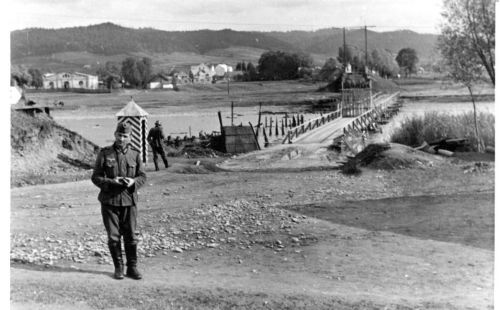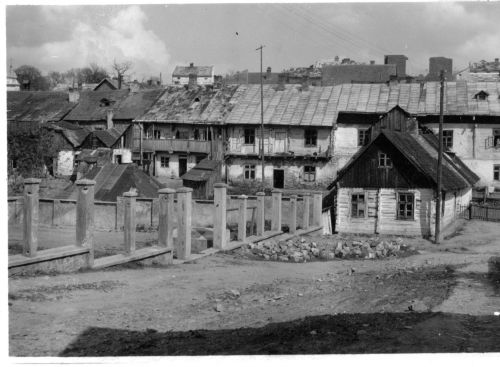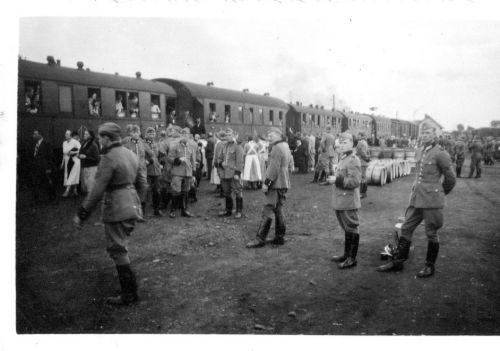Sanok

Sanok - German soldiers by the River San (Chris Webb Private Archive)
Sanok is located approximately 124 miles south-east of Krakow. In 1938, there were 4,773 Jews living in Sanok. At the onset of the Second World War in September 1939, more than 5,000 Jews were living in Sanok, including a number of refugees from Germany, Austria and western Poland.
German armed forces occupied Sanok on September 8, 1939. A few days later on the night of September 16-17, 1939, the Germans burned down three synagogues and destroyed two Jewish printing houses and libraries, containing some 4,000 volumes. On September 26, 1939, the Germans ordered 150 Jewish families to cross the River San into the Soviet controlled zone of occupation. The 'Aktion' was organised by Einsatzkommando 1/1. Jews from Krakow, Bochnia, Tarnow, Krosno, and Rymanow were also deported into the Soviet Zone via Sanok, and others came to Sanok, attempting to cross the border voluntarily. By the end of 1939, the Soviet authorities had more or less closed the border.
In October 1939, Sanok became a Kreis centre within the Distrikt Krakau. The first Kreishauptmann was Dr. Schaar, until he was succeeded by Dr. Class, during the second half of 1941. Dr Class performed this role until early 1943. Primarily responsible for the anti-Jewish 'aktions' in Sanok was the Border Police Office, especially the members of its Gestapo section.
In the autumn of 1939, the Germans started to confiscate and liquidate Jewish businesses. From December 1, 1939, Jews aged over twelve had to wear armbands bearing a blue Star of David. The Germans appointed Leon Werner as Chairman of the Jewish Council (Judenrat), which had to provide a daily quota of forced labourers aged between fourteen and sixty. More wealthy Jews, however, were permitted to pay for replacements. Jewish men worked mainly at cleaning and repairing the streets, while women and children either worked as domestic servants, or were forced to gather rocks from the River San, The Jews were poorly paid and malnourished, so they had to barter possessions for food on the black market.

Sanok Ghetto (Chris Webb Private Archive)
On their arrival, German officials started to evict Jews, in order to occupy their apartments, and Jews also had to meet German demands for furniture. Soon the Jews expelled from their homes, and those living in other areas of the town were all required to move into several designated Jewish residential areas within Sanok. The movement of Jews was restricted; they could leave the town only up to a distance of 1 kilometer and only during specific hours. To travel further afield, they required special permits issued by the Kreishauptmann. The penalty for disobeying these rules was death. The decree for Jews to move into these designated areas, effectively created an open ghetto.
As of December 1940, there were about 9,000 Jews in the Kreis Sanok, of which some 2,500 lived in the centre. According to a report of the Jewish Social Self Help (JSS) in July 1941, there were 2,700 Jews in Sanok, including 140 merchants, 120 skilled workers, of which 68 owned businesses (mainly tailors, shoemakers, and tinsmiths), 200 labourers, 6 self-employed and 600 unemployed.
Furthermore, 350 Jews were receiving assistance, while another 550 had applied for aid. The community kitchen distributed daily, meals to 175 Jews; 102 Jews received medical treatment and 144 families were receiving financial assistance. In September 1941, the Sanok JSS reported there were 2,400 Jews in the town, of whom 334 were receiving assistance; 30 Jews were performing forced labour. Around the time of Rosh Hashanah, the Gestapo arrested a group of Jews while praying and deported them to the Auschwitz Concentration Camp.
On December 12, 1941, the Kreishauptmann in Sanok introduced a law restricting the residence of Jews within the Kreis. Jews who were not permanent residents before June 22, 1941, were not permitted to settle in Kreis Sanok. Any Jews who had arrived after this date were required to leave the area. The Judenrat were required to report any Jewish newcomers to the office of the Kreishauptmann. Violators of the law would be severely punished. In the winter of 1941 - 1942, the Jews had to surrender all items of fur clothing to the German authorities, which were sent to the troops freezing to death on the Eastern Front.
From the spring of 1942, the Gestapo in Sanok conducted repeated registrations of the Jews in the town, dividing those able to work and those unfit for work. From this time, members of the Gestapo regularly arrested groups of Jews and shot them in the Jewish cemetery on Kiczury Street. The Judenrat was forced to send Jews to bury the bodies. Among the victims were Jews who had appealed against their categorization as unfit for work and probably some who had returned from Distrikt Galizien, but others were shot more or less at the whim of the Gestapo. After the town had been liberated the Polish authorities uncovered more than thirty mass graves, which contained the bodies of approximately 1,000 Jews. The other Jewish cemetery was razed by the Germans and the tombstones were used to pave a number of roads.
In mid-Summer 1942, the Germans dissolved the separate Jewish quarters in Sanok, and established a single enclosed ghetto in the town, which was closely guarded. Jews could only leave with a special pass to go to their places of work. Jews caught outside the ghetto without permission faced the death penalty. The ghetto was located on Jagiellonska Street and covered 2,000 square meters. Initially, approximately 2,500 Jews inhabited the ghetto, but additional Jews were brought there from other places in the Kreis. Some Jews left the ghetto daily to work on road construction and at a railway carriage factory. Others worked in a labour camp based at the Trepcza quarry on the outskirts of Sanok. The death rate in the ghetto reportedly was around two people per day.
In preparation for the mass deportation from Kreis Sanok, the Germans also established a transit camp for Jews at Zaslaw, about five miles south of the town. This was an unfinished paper factory, with its own railhead, that was surrounded by barbed wire. The only accommodation was in primitive barracks. From the middle of August 1942, the Germans started to concentrate Jews in Zaslaw. For example Jews from Bukowsko, Lesko, and Ustrzyki Dolne, arrived in Zaslaw camp. The camp's location within a factory was exploited by the Germans to make the Jews believe they would find employment there, but in fact most were deported to the Belzec death camp within days of their arrival.

German Gendarmes at Sanok by a train (Chris Webb Private Archive)
On September 5, 1942, the Germans announced on placards that all the Jews in the Sanok ghetto would be taken to the Zaslaw camp. Then on September 10, 1942, the German police, assisted by Ukrainian auxiliaries, conducted a major deportation 'Aktion.' The Jews were ordered to appear with luggage in front of their houses, leaving their keys behind. It was announced that anyone providing assistance to Jews would be punished by death. The Jews of Sanok were taken to the Zaslaw camp, where in total more than 11,000 Jews from the region were crammed into barracks suitable for only approximately 500 people. The sick and the disabled were shot at the Jewish cemetery in Sanok. After a few days, some 4,000 Jews from Kreis Sanok were deported to Belzec death camp. Soon afterwards, two more transports carrying approximately 9,000 Jews were sent from Zaslaw to the Belzec death camp.
On September 14, 1942, Kreishauptmann Class announced the creation of three separate Jewish camps within Kreis Sanok; Sanok, Trepcza, and Zaslaw. In this manner the Germans attempted to lure out of hiding the remaining Jews, promising them survival. Approximately 300 Jews had remained in the Sanok ghetto. The Germans soon killed most of the Jews that emerged.
In the autumn of 1942, approximately 100 Jews were retained to clear the area of the ghetto, whilst several hundred others lived in the Trepcza camp and other workplaces in Sanok, now converted into barrack-camps. In mid-December 1942, the Gestapo shot remaining members of the Judenrat in the Jewish cemetery. Also in December 1942, the Trepcza camp was liquidated, and approximately 700 Jews were transferred to Zaslaw, where they were shot the next day.
In January 1943, the remaining Jewish labourers in Sanok were gathered together and then sent to the Zaslaw camp, where they were either murdered or sent to some unknown destination. Some Jews managed to escape the liquidation of the ghetto and went into hiding. The Germans conducted manhunts in the nearby villages. In Bykowce, the Germans shot three Jewish escapees from the Sanok ghetto. In Dabrowka, the Gestapo shot fourteen Jews. On April 19, 1944, Stanislaw Kornecka was executed by the Germans for sheltering a Jew.
Sources
Encyclopaedia of Camps and Ghettos 1933- 1945, USHMM, Indianna University Press Bloomington and Indianapolis 2012
Photographs - Chris Webb Private Archive
© Holocaust Historical Society 2019

